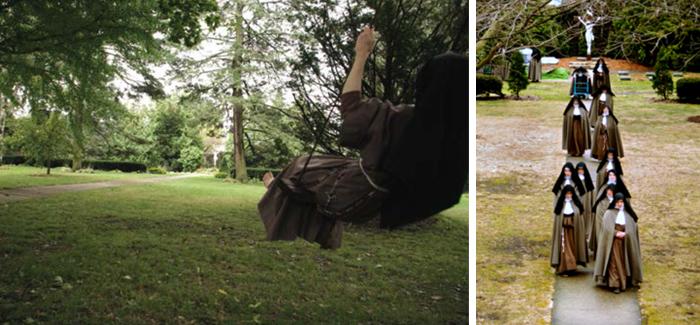
(Photography by Abbie Reese, MFA’13)
Cloistered nuns tell their stories.
This winter, Oxford University Press published Dedicated to God: An Oral History of Cloistered Nuns by Abbie Reese, MFA’13. Reese visited the Corpus Christi Monastery of the Poor Clare Colettine Order in Rockford, Illinois, over eight years, patiently gaining the trust of the nuns who live there and capturing their stories. Fewer and fewer women are making their choice; from 1970 to 2010, the number of religious sisters worldwide fell almost 30 percent. As of the book’s publication, there were 20 nuns in the Rockford cloister. Their observance of their vows—of poverty, chastity, obedience, and enclosure—is strict even by monastic standards. But Reese found the nuns disarming, open, and more diverse in their beliefs than she expected. Together with Reese’s luminous photographs, their words reveal the complexity of what only appears to be a simple life.—Laura Demanski, AM’94
During one of my first visits to the Corpus Christi Monastery, the mother abbess allowed me to sit in on a meeting with a young woman visiting for the weekend as a prospective member. It was 2005. I had told the mother abbess that I would be a fly on the wall. But after they talked for a while, I made a comment or asked a question. Mother Miryam stared me down. “A fly on the wall, eh? I wish I had a swatter.” I was stunned into silence. Then I laughed. She smiled. In spite of my blunder, I had passed a test.
Almost a decade has lapsed since I first visited this community of cloistered contemplative nuns in one of the strictest religious orders in existence. I am often asked why the nuns granted access. Like any relationship, my engagement with these women, who seek anonymity (each choosing an alias for this project), is based on negotiations and trust developed over time. By 2008 I was invited further into the enclosure to make still photographs. My friend Pieralberto Deganello, U-High’91, AB’94, years ago joked that I am a “nun whisperer.” I told the mother abbess this, and she laughed.
I am not Catholic. I started this project believing that there would be value in learning the stories of those who, as Mother Miryam told me, are “erased from the landscape.” Cloistered nuns’ stories are not in the public records, or known to one another since they observe monastic silence—speaking only as much as necessary in order to complete a task, other than during one hour of recreation each evening when they can talk freely. This withdrawal from the world, they believe, allows them to intervene on behalf of humanity in their prayer. “It’s the hiddenness,” Sister Sarah Marie told me. “It’s the little, pulled away, hidden, nobody really knows about you, nobody really cares, might not even care to know about you, that does—it has, I think, tremendous impact.”
The project came into being because I wanted to understand what compels young women today to make such a countercultural commitment. Each said that she was called; faith allowed them to accept, in spite of their own desires and God-given personalities.
The severity of their lives is striking. During the four visits permitted each year, the nuns and their loved ones are separated by a metal grille and are are not supposed to reach through the bars to touch one another. They give family members one final hug during the ceremony when they make final vows.
I have been humbled by their openness with me and inspired by the grace and the space that they extend to one another. Mother Maria Deo Gratias told me that when she passes another nun in the hallway, she bows a little. She nods to her religious sister and to the other nun’s guardian angel. It wouldn’t be courteous to greet one and not the other, she said.
My methodology has shifted as our collaboration has evolved. Heather, who was trained as a painter and was a blogger, joined the order in 2011. Wondering what would happen, I lent her a video camera to document her world. During a talk at Temple University, I showed a demo of the collaborative ethnographic film in progress. An art history student working on French nuns in the 18th century thanked me for contributing to the historical record and asked: Are you concerned that the video sensationalizes the nuns’ lives and in 200 years will cause people to misunderstand those lives? In interviews and photographs, I told her, the nuns share what they want to and construct their performances. Heather, who is 27, is a product of a reality television culture and chose to make self-scrutinizing video diaries in that style. I understand the student’s concern but don’t share it.
During St. Martin’s Lent, the mother abbess arranged for me to visit the monastery to watch a slide show the nuns made in the 1950s and still show to young women visiting to discern if they have a calling. They had updated it using some of my 3,600 photos. Sister Mary Nicolette told me that the nuns were reading Dedicated to God and learning about the lives of their own members. She had finished the book and said that it is “true,” that it is the nuns “without any makeup.” At her request, I printed out Amazon.com reader reviews. Mother Maria Deo Gratias read the reviews in the parlor while I copied their new slide show to my laptop. Reading a review that wanted the order’s rules included, Sister Maria Deo Gratias defended me, saying the reader wanted what I had not aimed to create. Another review questioned my knowledge of Catholicism. Mother Maria Deo Gratias said, “You didn’t know at the beginning. You wanted to learn.”
